Alien Skin's Exposure 3: More Fun than is Legal
I was going to call this section "Film for Your Digital Camera", but decided that "Alien Skin's Exposure 3: More Fun than is Legal" was more accurate. As much as I like digital photography and all of its advantages, some days I miss the look of film. I remember buying Fuji film when I needed to accentuate greens. I remember Kodak's Vericolor 100 that produced superb portraits. Kodachrome, particularly the 25-speed stuff, gave bright and highly saturated colors. When Kodachrome II came along, Paul Simon even sang about it. It's possible to replicate the look and feel of those films if you want to spend hours (or maybe days) tweaking some of Photoshop's settings. Or you can use Alien Skin's Exposure 3.
Allow me to introduce you to Phoebe (on the left) the Chloe (on the right). Chloe is small. Tiny might be a better description, so she has earned the name tinimus, which (because she's a she) should be tinima. From that, she has become Tiny Moose or, sometimes, just Moose. Let's see what we can do with a photo that includes Phoebe and Moose.
 Exposure 3 works with Adobe Photoshop CS3 through CS5, Adobe Lightroom 2 or 3, Adobe Photoshop Elements 7 or 8, or Corel Paint Shop Pro Photo X3 or X4 and is available in 32- and 64-bit versions.
Exposure 3 works with Adobe Photoshop CS3 through CS5, Adobe Lightroom 2 or 3, Adobe Photoshop Elements 7 or 8, or Corel Paint Shop Pro Photo X3 or X4 and is available in 32- and 64-bit versions.
At the right is the image I started with.
 Technically, the most significant new features include 64-bit support for Photoshop CS5 on both Macintosh and Windows because digital manipulation needs all the power it can get; integration with Lightroom in a way that does not require Photoshop because not every photographer can afford all the tools; lots of new "starter" settings in all categories with the ability to modify them in nearly infinite ways; and faster preview even in the 32-bit version.
Technically, the most significant new features include 64-bit support for Photoshop CS5 on both Macintosh and Windows because digital manipulation needs all the power it can get; integration with Lightroom in a way that does not require Photoshop because not every photographer can afford all the tools; lots of new "starter" settings in all categories with the ability to modify them in nearly infinite ways; and faster preview even in the 32-bit version.
The Autochrome process (above at the right) was invented in France in 1907.
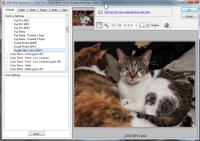 Reality and fantasy. If you're looking for the realistic look of 1968's Kodachrome II or 1910's Autochrome, Exposure 3 delivers. If you're looking for an appearance that no film has ever offered, Exposure 3 delivers.
Reality and fantasy. If you're looking for the realistic look of 1968's Kodachrome II or 1910's Autochrome, Exposure 3 delivers. If you're looking for an appearance that no film has ever offered, Exposure 3 delivers.
Here I've selected Kodak Ultra Color 100UC as my film type.
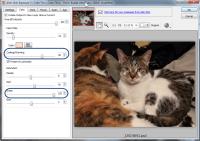 Now I've modified the color a bit and enhanced the green slightly.
Now I've modified the color a bit and enhanced the green slightly.
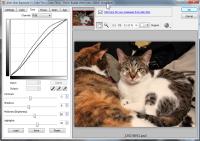 I've adjusted the curve slightly to lighten the image a bit.
I've adjusted the curve slightly to lighten the image a bit.
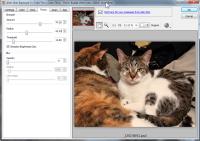 Here's the control panel that's used to increase or decrease sharpness.
Here's the control panel that's used to increase or decrease sharpness.
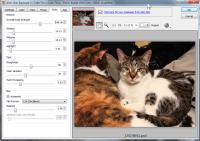 I found only one small inconsistency to quibble about and you'll see that in the accompanying TechByter video. One of the effect types ages the image by adding dust and scratches. For slide films, the effect seems to be reversed.
I found only one small inconsistency to quibble about and you'll see that in the accompanying TechByter video. One of the effect types ages the image by adding dust and scratches. For slide films, the effect seems to be reversed.
This is the control panel where you can age the image.
- On negative film a scratch will create a dark area when a print is made and dust will create light areas: The scratch goes through the emulsion and allows light to pass while a dust speck blocks light.
- On positive film (slides) a scratch creates a clear area on the film and is white when the image is projected or printed while dust blocks the light and appears as a dark spot when the image is printed or projected. Alien Skin's dust specks on chrome films are light when they should be dark.
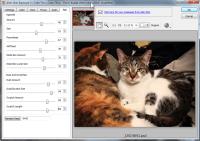 This is a negative film, so the scratches should be dark (they're light). The dust spots should be light, too, and they are.
This is a negative film, so the scratches should be dark (they're light). The dust spots should be light, too, and they are.
In all, Exposure 3 has more than 500 presets to create effects that you could create in Photoshop, but only with a great deal of work. And, as always, Alien Skin makes the modifications non-destructive by applying them to a new layer by default. You can always get back to your original image.
Exposure 3 is a $250 product, but owners of earlier versions may upgrade for $100. If you purchased Exposure 2 in or after April of this year, you should already have the upgrade, free.
 Here's my final image. It looks like something from the early 1970s—possibly a Kodachrome 25 slide printed to the extremely contrasty paper used for type R (positive-to-positive) prints in those days.
Here's my final image. It looks like something from the early 1970s—possibly a Kodachrome 25 slide printed to the extremely contrasty paper used for type R (positive-to-positive) prints in those days.
Controls At Your Finger Tips
The TechByter video shows some of the many controls available on the Exposure 3 menus. If the default settings are exactly what you want, you can stop there. But if you want a slightly different look, it's easy:
Alien Skin Exposure 3 Is Entirely Too Much Fun from Bill Blinn on Vimeo.
For the highest possible quality, follow the link to the Vimeo site and watch the full-screen version there. The embedded version here is degraded significantly.
The Incredible Variety of Film
With more than 500 basic options, Exposure 3 doesn't lend itself to a complete test drive. So let's look at 11 options that I selected more or less at random.
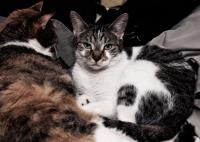 Bleach Bypass: The bleach bypass process reduces or eliminates the bleaching function during the processing of a color film or paper. Bleach removes silver, so skipping the bleach retains the silver along with the color dyes. The result is a black and white image that is superimposed on the color image.
Bleach Bypass: The bleach bypass process reduces or eliminates the bleaching function during the processing of a color film or paper. Bleach removes silver, so skipping the bleach retains the silver along with the color dyes. The result is a black and white image that is superimposed on the color image.
 Copper Print: Copper, selenium, and other metals have been used in photography. This is an example of copper with an added light vignette.
Copper Print: Copper, selenium, and other metals have been used in photography. This is an example of copper with an added light vignette.
 Daguerreotype: Louis Daguerre's process used asphaltum on a copper plate sensitized with lavender oil. Long exposures were required and the image in a Daguerreotype was formed by combining mercury and silver. This was a hazardous process that used mercury vapor to develop the copper plate that was coated with a thin layer of silver. Exposure 3 makes it safe and easy.
Daguerreotype: Louis Daguerre's process used asphaltum on a copper plate sensitized with lavender oil. Long exposures were required and the image in a Daguerreotype was formed by combining mercury and silver. This was a hazardous process that used mercury vapor to develop the copper plate that was coated with a thin layer of silver. Exposure 3 makes it safe and easy.
 Kodachrome: This is the film Paul Simon sang about: "They give us those nice bright colors. They give us the greens of summers. Makes you think all the world's a sunny day." Kodachrome the way it looked in the late 1960s and early 1970s.
Kodachrome: This is the film Paul Simon sang about: "They give us those nice bright colors. They give us the greens of summers. Makes you think all the world's a sunny day." Kodachrome the way it looked in the late 1960s and early 1970s.
 Ekatchrome: Ekatchrome was easier to process than Kodachrome and anyone could do it (only Kodak-owned labs were allowed to process Kodachrome) but it tended to have a blue cast.
Ekatchrome: Ekatchrome was easier to process than Kodachrome and anyone could do it (only Kodak-owned labs were allowed to process Kodachrome) but it tended to have a blue cast.
 Kodak Portra 400: This has the look of Kodak Portra with a 400 ASA rating. Portra was Kodak's portrait film, although a 100-speed film was generally used in studios. You might find the 400-speed variety at weddings.
Kodak Portra 400: This has the look of Kodak Portra with a 400 ASA rating. Portra was Kodak's portrait film, although a 100-speed film was generally used in studios. You might find the 400-speed variety at weddings.
 Kodak Portra 400 VC: This is also Kodak Portra 400, but the VC version. VC stands for "vivid color", so it is generally not used for portrait work. The Portra family of daylight-balanced professional color negative films is still available in 160, 400, and 800 ISO.
Kodak Portra 400 VC: This is also Kodak Portra 400, but the VC version. VC stands for "vivid color", so it is generally not used for portrait work. The Portra family of daylight-balanced professional color negative films is still available in 160, 400, and 800 ISO.
 Polaroid: Remember Polaroid? Being able to see your picture in just a minute or two was a radical thought in those days, even if the color wasn't the greatest. Later Polaroid films (this is type 600) improved color but Polaroid was digital photography's first victim.
Polaroid: Remember Polaroid? Being able to see your picture in just a minute or two was a radical thought in those days, even if the color wasn't the greatest. Later Polaroid films (this is type 600) improved color but Polaroid was digital photography's first victim.
 Rodinal developer: This image highlights a developer, not a particular film or paper. Rodinal was patented in 1891 and was the first product sold by Agfa. Rodinal is still available today, sometimes under other names because the patent expired. Rodinal was popular with amateur photographers because it was supplied in liquid form, could be mixed in single batches, and was used just once.
Rodinal developer: This image highlights a developer, not a particular film or paper. Rodinal was patented in 1891 and was the first product sold by Agfa. Rodinal is still available today, sometimes under other names because the patent expired. Rodinal was popular with amateur photographers because it was supplied in liquid form, could be mixed in single batches, and was used just once.
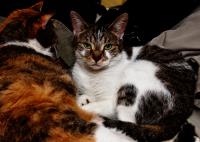 High saturation: This is another image that reflects a process instead of a film of paper. Color slide film could be exposed and developed in a way that created a high-contrast image with extremely saturated colors. Just like this.
High saturation: This is another image that reflects a process instead of a film of paper. Color slide film could be exposed and developed in a way that created a high-contrast image with extremely saturated colors. Just like this.
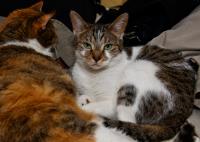 Technicolor: Although used for movies, Technicolor is one of the options available from Exposure 3, which includes filters for Technicolor process 2 and Technicolor process 4. The Technicolor process dates back to 1914.
Technicolor: Although used for movies, Technicolor is one of the options available from Exposure 3, which includes filters for Technicolor process 2 and Technicolor process 4. The Technicolor process dates back to 1914.
 Bottom Line: Exposure 3 takes the digital out of digital photography.
Bottom Line: Exposure 3 takes the digital out of digital photography.
That's not my line. It's Alien Skin's tag line and it's appropriate. If you at least occasionally miss the look of film, Exposure 3 makes recovering that analog appearance possible without the cost of film, the time required to process film, or the nasty chemicals. Along the way, you may find that you're having more fun than is permitted in at least 27 states.
For more information, visit the Alien Skin website.
University of the People
You probably find your e-mail in-box stuffed with "offers" of "degrees" based on your "experience". You can buy a high-priced worthless piece of paper (some even come with phony transcripts), but they're still worthless. At the other end of the spectrum, many legitimate colleges and universities now offer distance learning programs. Now there's a third kind of player: One that offers low-cost education, but no degrees.
University of the People is located in Pasadena. The non-profit school has no campus and charges no tuition. The goal of the founder, Israeli entrepreneur Shai Reshef is to bring higher education to what he calls "disenfranchised communities" around the world.
Today the course offerings are minimal, just two tracks: Business Administration and Computer Science, but these are two subject areas that lend themselves to distance learning and will also be useful in developing countries. It also offers a "general studies" track with classes in business English, calculus, history, and introductory classes in philosophy, sociology, and psychology.
University of the People cannot confer degrees in these areas because it is not accredited by any organization. Reshef says the he hopes to obtain accreditation but that he cannot predict when, or whether, accreditation might be granted. It's likely that traditional institutions will oppose accreditation and this could leave the organization's students without a true diploma.
Active and retired professors and other professionals work with University of the People. The school uses peer-to-peer teaching when possible to make the best use of its student body. Students share resources, exchange ideas, discuss weekly topics, submit assignments, and take exams online.
Although tuition is free, the school charges application fees of $15 to $50 and assessment fees ranging from $10 to $100. The fees are based on the economic situation of each student.
Reshef founded University of the People in January 2009 and to fund its programs and provide services to students, the school accepts donations of money and time.
The next classes will begin in August. The school currently has some 500 students from Nigeria, Jamaica, Canada, Indonesia, Zambia, Brazil, Spain, and Pakistan.
For more information, visit the Univeresity of the People website.
Have You Driven Chrome Lately?
"When I open an XML file in Chrome," a co-worker grumbled, "nothing happens." He uses and Mac and I decided to see what would happen on my Windows PC. Same thing: Nothing. So I looked to see if there was a setting to control XML display. There isn't, but there was an extension that enables XML display. Extensions? That's always been Firefox's strength.
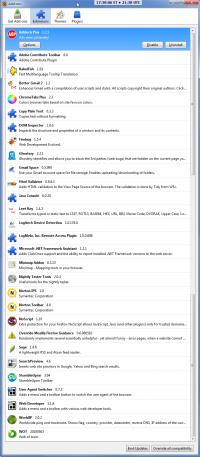 This changes the equation fundamentally. Chrome is faster than Firefox. If a site causes Chrome to crash, the crash doesn't take the whole browser with it as is the case with Firefox. If Chrome now has a good collection of extensions, it might begin to eat into Firefox's market share.
This changes the equation fundamentally. Chrome is faster than Firefox. If a site causes Chrome to crash, the crash doesn't take the whole browser with it as is the case with Firefox. If Chrome now has a good collection of extensions, it might begin to eat into Firefox's market share.
At the right is my Add-ons control panel from Firefox.
Next I compared my list of Firefox extensions with what's available for Chrome. I score 1 for Chrome if the extension (or an equivalent) is available, -1 if the extension is unavailable, and 0 if the extension is unavailable but is one I don't use or consider frivolous.
- AdBlock Plus: Available. Score: 1.
I consider this essential. I'm not opposed to ads, but when a site serves me an ad that sings, dances, or bounces around while I'm trying to read the text, I block the ad. - Adobe Contribute Toolbar: Not available, but I don't use this in Firefox. Score: 0.
This works in conjunction with Adobe Dreamweaver and is installed when Dreamweaver is installed. It's not something I use. - BabelFish: Google Translate. Score 1.
Instant translations are helpful and it's a feature I added this year to the TechByter website. The Chrome plug-in works directly with Google's translation service. - Better Gmail: "Unofficial" version is available. It's in use by 50,000 people and, based on 419 reviews, has about a 4.5 rating on a 5-point scale. Score: 1
This extension allows the user to change how Gmail works. If you never use the chat function, for example, you can turn it off. - Chroma Tabs: Unavailable, but this is a cosmetic-only feature. Score: 0.
- Copy Plain Text: "Copy Without Formatting" is the equivalent. Score: 1.
- DOM Inspector: No such extension is available, but this feature is built in to Chrome. Score: 1.
- Firebug: Firebug Lite is available: The developer says "Firebug Lite is not a substitute for Firebug, or Chrome Developer Tools. It is a tool to be used in conjunction with these tools. Firebug Lite provides the rich visual representation we are used to see in Firebug when it comes to HTML elements, DOM elements, and Box Model shading. It provides also some cool features like inspecting HTML elements with your mouse, and live editing CSS properties." So I also installed the Chrome Web Developer Tools. Score: 1.
- Ghostery: Available. Score: 1.
What tracking devices are installed on the website? Ghostery lets you know. On the TechByter site, for example, you'll see that Statcounter and Share This are in use. Statcounter reports the number of visitors to the site each week and Share This allows visitors to post information about a given program to one or more of the social networking sites. - Gmail Space: Not available, but I never use it because it's slow and cumbersome. Score: 0.
This add-on allows the user to treat a Gmail mailbox as a disk drive. It's slow and cumbersome to use, so I don't use it. - HTML Validator: Available. Score: 1.
Essential. This extension gives me a quick look at the HTML code and checks it for errors. - Java Console: Unavailable. The Java Console extension is no longer supported as of JRE 1.6.0.10, so it needs to be removed from Firefox. It is not needed in Chrome because Java is supported once the Java application is installed. Score: 1.
- Leet Key: Unavailable. Score: -1.
This is primarily a trivial extension, but it does have the ability to encode and decode ROT13 text, which a few people still use. - Logitech Device Detection: Unavailable, but unnecessary. Score: 0.
Logitech installed this to identify installed Logitech devices. It is not an essential extension. - Microsoft Net Framework: Unavailable, but unnecessary. Score: 0.
- Minimap Add-on: Google Maps Minimap. Score: 1
This extension can pop up a quick map to show a location. - Nightly Tester Tools: Unavailable, but unnecessary. Score: 0.
Essential with Firefox because it allows the user to enable extensions that stop working when Firefox upgrades the browser. Not needed with Chrome. - Norton IPS and Norton Toolbar: Unavailable. Score: 0.
These are security tools, but often tools like these provide more of a sense of security than any real security—like the TSA at our nation's airports. Web of Trust (below) is an adequate replacement, so I'm scoring this as 0. - Override Mozilla Firefox Guidance: Unavailable, but it's installed only for comic effect. Score: 0.
When a page fails to load, the browser will display a standard message. This extension overrides those standard messages with silly, and sometimes profane, messages that are every bit as useful as the standard messages. - Sage: Equivalent programs available, but I didn't install any because I don't use Sage. Score: 1.
This is an RSS aggregator, but I have other tools for viewing RSS feeds. - Search Preview: Search Preview for Google is available. Score: 1.
A Google search will return thumbnail images of the websites that the search located. I have found this to be uncommonly helpful in selecting a site from the list. - Stumble Upon: Available. Score: 1.
Fun. Entertaining. Possibly educational. Possibly a huge time sink. Stumble Upon is all these. - User Agent Switcher: User Agent Switcher for Chrome. Score: 1.
Some site designers still design their websites to work with Internet Explorer. When you encounter one of these misguided folks' sites, it's possible to have Firefox or Chrome pretend to be Internet Explorer. 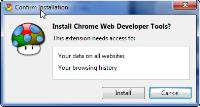 Web Developer: Available. Score: 1.
Web Developer: Available. Score: 1.
This is a useful website development tool that works well in conjunction with Adobe Dreamweaver. The installer tool is particularly forthcoming with information about the access the each extension requires.- World IP: Unavailable: Score -1.
Every website has an IP address. The IP address identifies, among other things, the country where the site is located. - Web of Trust: Available. Score: 1.
What kind of reputation does a website have? This service uses social networking to classify sites on 4 key criteria.
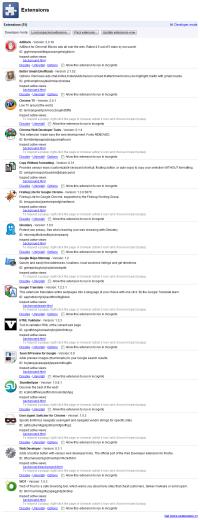 Best possible score: 27.
Best possible score: 27.
Actual score: 14.
Chrome's score is lower than it should be with this scale. If I omit the unnecessary Firefox extensions from the possible high score, the maximum high score would be in the range of 19 to 20.
In short, the only Firefox add-in that I will really miss is World IP because it's helpful to know where a website is.
At the right you'll see my list of Chrome extensions. It doesn't contain everything that my Firefox list contains, but all of the essential tools are there.
If this doesn't worry the Firefox development team a bit, it should. And Microsoft is now facing a challenge from 2 competent browsers, each of which has fewer security problems than IE does.
Short Circuits
Accused Botnet Bozo Behind Bars
The Mariposa Botnet has infected millions of computers worldwide and has been used to steal credit card data, but now the creator of the botnet is said to be behind bars. US, Spanish, and Slovenian law enforcement agencies worked together to corner a 23-year-old Solvenian so far identified only as "Iserdo" and jail him.
Three other accused conspirators were arrested in Spain in February. Mariposa's goal was to steal credit card data, online banking passwords, account information for social networking sites, and other data that the operators could use. But it didn't stop there. Mariposa also spread viruses and launched denial-of-service attacks.
According to the FBI, Mariposa infected 8 to 12 million computers worldwide and Spanish police said the botnet was on computers in more than half of the largest US firms on the Fortune 1000 list.
The botnet has been out of operation since December 2009, the result of a joint operation involving the Spanish police, the FBI, and two private information security firms. The botnet is suspected in denial-of-service attacks in 2007 against Estonia and Georgia. The attacks coincided with diplomatic tensions between the Estonia and Russia and between Georgia and Russia.
Kindle! $139! (Or Is It?)
I like the idea of the Kindle, but I don't own one. Amazon is making a big deal out of its recent price drop. The Kindle is just $139 with free 2-day shipping. But if you continue reading, you'll find that there's another model for $189 and a third for $379. What's the difference? Let's take a look.
For $139 or $189, you get a device with a 6-inch (diagonal) screen. It weighs about 9 ounces and includes native support for PDF documents. At the low end, you don't get "free 3G wireless" that's included with the $189 and $379 model.
For $379, you get a much larger (9.7-inch diagonal) screen and more weight (19 ounces).
Amazon has almost convinced me to buy a Kindle.
Some books are available for free: More than 1.8 million free, out-of-copyright, pre-1923 books are available. Example: Pride and Prejudice.
All 3 devices hold an entire library: Kindle's storage lets you take "up to" 3,500 books with you. I'm always worried about "up to" in ad copy, but the main point is that you can carry a lot more books with you than you can read on any business trip or vacation.
The top 2 models include free 3G wireless. To quote Amazon, "No annual contracts, no monthly fees. Download books anytime, anywhere." At this point, I clicked the more information button. "Travel the globe and still get books in under 60 seconds. Kindle uses GSM technology—the most popular mobile wireless standard—with wireless coverage in over 100 countries and territories, such as Australia, Hong Kong, Germany, Japan, Norway, Spain, South Africa, the United Kingdom, and many others. Stay in touch with news from home by having your newspaper and magazine subscriptions delivered wirelessly while you travel. See wireless coverage map for availability. For U.S. customers traveling abroad, additional charges apply for wireless delivery of periodical subscriptions. To avoid any charges, you can always download items via your computer and transfer them to your Kindle using USB or a Wi-Fi connection."
 There was also a section about "no monthly wireless bills or annual contracts": "Amazon pays for Kindle's wireless connectivity so you won't see a monthly wireless bill. There is no wireless setup—you are ready to shop, purchase, and read right out of the box. Your Kindle may use wireless connectivity to make other services available, such as wireless delivery of personal documents, which may require an additional charge. For more information, see Wireless Terms and Conditions."
There was also a section about "no monthly wireless bills or annual contracts": "Amazon pays for Kindle's wireless connectivity so you won't see a monthly wireless bill. There is no wireless setup—you are ready to shop, purchase, and read right out of the box. Your Kindle may use wireless connectivity to make other services available, such as wireless delivery of personal documents, which may require an additional charge. For more information, see Wireless Terms and Conditions."
And they keep adding things I'd like: "Kindle automatically detects nearby Wi-Fi networks at school, home, or your favorite café. At a hotel or café that requires a password? Simply enter the password and connect to the network. Once you have added a Wi-Fi network, Kindle will automatically connect to that network the next time you're near the hotspot. Kindle does not currently connect to enterprise or peer-to-peer networks. Enjoy free Wi-Fi access at AT&T hotspots across the U.S. for shopping and downloading Kindle content—no AT&T registration, sign-in, or password required."
Oh—and because the publisher doesn't have to print, bind, and deliver a physical book, e-books cost less. "Over 510,000 books are $9.99 or less, including 80 current New York Times Best Sellers."
Hmmm. I'm beginning to think that I see a Kindle in my future.


 The author's image: It's that photo over at the right. This explains why TechByter Worldwide was never on television, doesn't it?
The author's image: It's that photo over at the right. This explains why TechByter Worldwide was never on television, doesn't it?
